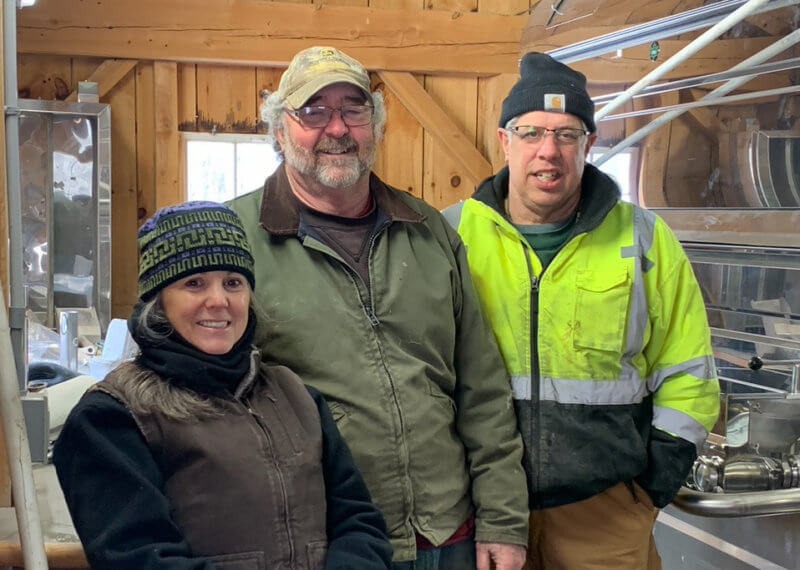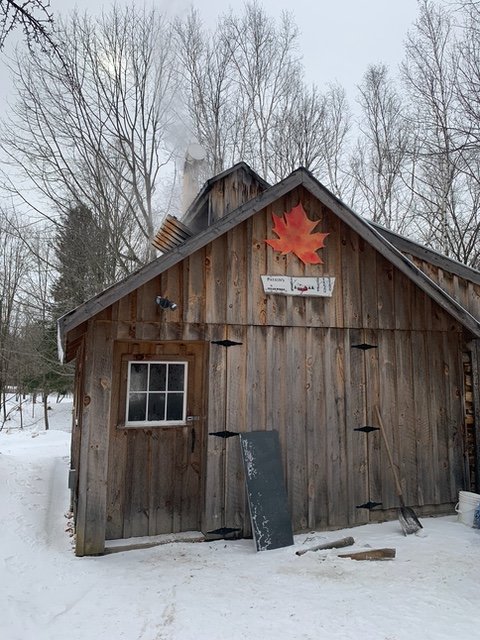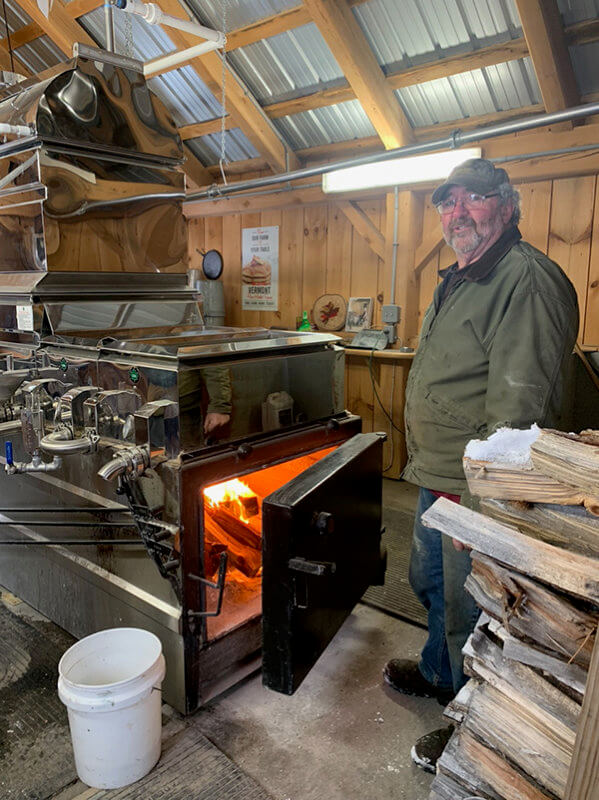[ad_1]
By Lucie Lehmann, Contributor
Looking ahead to this year’s sugaring season, Pat Leclaire, 66, invested in a new steam pan for his sugarhouse on Lime Kiln Road. The lifelong Charlotter was excited about its prospects — the pan preheats the maple sap by capturing the energy from the evaporator’s flue pan, reducing the amount of firewood needed and increasing efficiency by 30-40 percent.

Pat and Aline Leclaire with Peter Curler. Photos by Lucie Lehmann.
The 2022 season didn’t start off smoothly, though. The 500 gallons of sap that Leclaire had just collected from trees around Charlotte were in tanks, ready to be boiled. But soon after he stoked the fire in the arch, or firebox, and the temperature in the sugarhouse began to rise, excessive amounts of condensation poured from the new steam pan, likely from a faulty gasket. Leclaire had to shut the whole operation down for several hours while he and several others, including his wife, Aline, 59, and their friend and fellow sugar maker, Peter Curler of East Charlotte, worked on the problem.

The Leclaire Sugarhouse.
The sap did eventually get boiled, yielding the first gallon of dark, robust maple syrup of 2022 by mid-afternoon. It perfectly illustrated a paradox in the most unique and enduring of Vermont traditions: Things have changed in maple syrup production. Plastic tubing has mostly replaced traditional buckets for sap collecting, and the use of reverse osmosis systems to more quickly reduce the water content in the sap is common. Leclaire favors traditional boiling methods in part because he thinks the flavor of the syrup is superior and also “because it’s Vermont,” but he keeps abreast of the innovations and invests in them selectively.
Warming weather is one of the changes no one has control over. Leclaire and Curler both sugared as children on their parents’ farms and remembered March 1, Town Meeting Day, as the traditional start of the sugaring season. Now it’s easily 10 days earlier.
Extremely warm days are more frequently as well. A spate of 70-degree weather last March ended the sap run early and abruptly, with markedly decreased yields. Production of maple syrup in Vermont dropped 21 percent last year, according to USDA’s National Agricultural Statistics Service.
The state still leads the nation in maple syrup production, generating about 46 percent of the total yield, but it’s a challenging time for sugar makers. This year, on top of everything else, COVID-related supply chain issues have created a shortage of containers and driven up their cost by as much as 50 percent.
Fortunately for Leclaire, while sugaring is a business, it isn’t the only source of income for the retired Green Mountain Power lineman. In fact, he reinvests all of his proceeds back into the business, which is fine by him as long as it doesn’t cost him anything extra. “If I had to take money out of my pocket to keep it going, I’d quit,” he said.

Pat Leclaire in his sugarhouse on Lime Kiln Road.
Perhaps, but it’s clear that for Leclaire, just as for Curler, making maple syrup is far more than what they jokingly refer to as “something to do in the spring.” It’s a proud way to carry on an iconic Vermont endeavor that requires skill, patience and some luck. To that end, both men still employ a few metal buckets on taps, Leclaire along the hedgerow in front of his property, where they catch the eye of visitors, and Curler in East Charlotte for his grandchildren, so that they, too, can participate in sap collecting.
To encourage people to learn about sugaring, Leclaire has an open-door policy at his sugarhouse, welcoming visitors from all over.
“If you see the steam rising, stop on in,” he says. The genial, bearded man loves showing people around and educating them, even taking them on sap collecting rounds.
“We had traveling nurses from the south, and Pat gave them a drill to tap the trees,” Aline recalls with a smile. “They were screaming when they saw the sap coming out. They were ecstatic to see the process.”
The 219 gallons of maple syrup that Leclaire produced last year, down from 250 gallons in 2020, was almost all sold locally, much of it in response to posts from Aline on social media. They like to keep it in the community, in part to show their appreciation for the support they’ve received around Charlotte since they started in 2012.
“The town has been amazing,” Aline says, singling out Philo Ridge Farms, The Yerbary, Backyard Bread and Red Barn Kitchen as businesses that have strongly backed them.
No one knows exactly how many sugarhouses there are in the state. Estimates vary from 1,500 to several thousand, but collectively Vermont produced 1.5 million gallons of maple syrup from 6 million taps last year, much of it made by small- to medium-sized sugar makers like Leclaire and Curler, who also sells locally, mostly by word of mouth and through relatives. Each man taps between 1,000-1,500 maple trees in a variety of locations.
Leclaire plans to keep sugaring until “the body says I can’t do the wood anymore,” he said, gesturing to the stacked cords that feed the arch.
Sugaring is hard work, and while Aline assists with sales and marketing and Leclaire has help with sap collection, notably from his friend Brian Fortin, it’s largely a one-man operation. When the sap is running, as it’s beginning to now, he’s often in the sugarhouse for up to nine hours at a time, tending carefully to the process. It all depends on the sugar content, which determines how long the sap needs to boil. The syrup is ready when the sugar content reaches between about 67 percent, or around 218 degrees.
If you’re passing the sugarhouse and the steam is rising, heed Leclaire’s invitation to stop in. You’ll be helping to keep the sugaring tradition going for another season. That you’ll probably also end up taking some syrup home is the sweetest reward of all — for everyone.
[ad_2]
Source link

